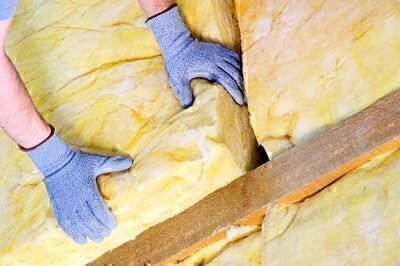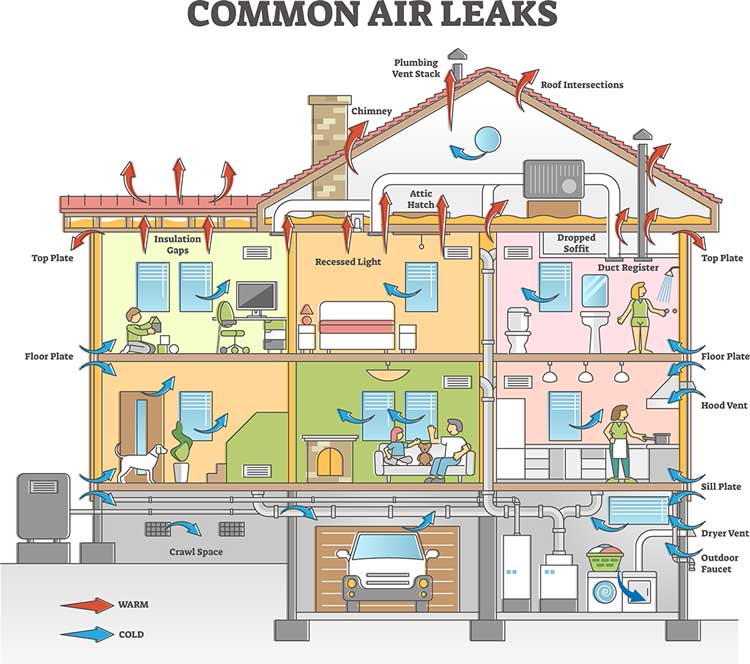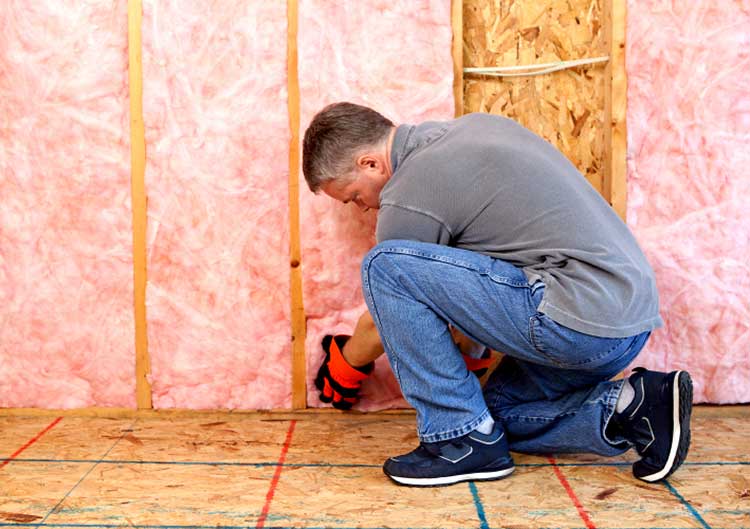Last updated November 2024

Looking for ways to consume less energy at home? Our section on how to save energy at home shares 30 ways to cut your utility costs—and help the planet. Many are cheap and effective.
As we discuss in that section, for many homes the most cost-effective energy saver is to install or add insulation in spots that need it, and to seal cracks and gaps to reduce air leakage. Heating is by far the biggest energy eater for Boston area homes, typically accounting for about 60 percent of utility expenses. If your home is under-insulated or has many air leaks, heat escapes during winter—along with your money. Improving insulation and eliminating air leaks will also make your home more comfortable.
Big Incentives Can Help Pay for Project Costs
The opportunities to save are especially large for Bay State residents, where programs exist to pay for most insulation and air-sealing projects.
Mass Save, a program offered by utilities operating in Massachusetts, offers rebates that pay 75 percent or more of costs for insulation improvements and reimburses all costs of air-sealing projects.
To qualify for Mass Save’s rebates, you first have to contact a program-approved contractor to perform a free energy audit and prepare a list of recommended improvements. Find approved contractors on the Mass Save website or by calling 866-527-7283.
The federal government provides additional incentives that will cover most or all costs for air-sealing and insulation improvements not paid for by Mass Save.
When preparing your tax return, you can claim the Energy Efficient Home Improvement Credit. It helps pay for 30 percent of unreimbursed costs, with a $1,200-per-year credit cap, for materials used for air sealing and insulation improvement projects. You can also use a portion of the $1,200 allowance to cover energy audit costs, up to $150. Click here for a full list of projects eligible for these tax savings.
Also, beginning sometime in 2025, households with incomes of less than $213,000 or so can qualify for rebates for air-sealing, insulation, and ventilation improvements. Rebate amounts will vary depending on your income; you’ll get back $800 or $1,600 (depending on income) for most insulation and sealing projects; there will be a separate program for those who make whole-house energy-efficiency improvements.
Click here for a list of energy-saving rebate programs available in the Boston area as of this writing. Also check EnergyStar.gov and with your utilities for up-to-date info.

First, Look for Leaks
One little leak might not seem like a big deal, but having several can add up to the equivalent of leaving open a small window. It usually costs very little money to identify and fix ways your home passively wastes energy, but it yields significant savings.
During Mass Save’s prescribed energy audit, the inspector will identify and seal easy-to-fix leaks. Most occur where different building materials meet—brick and wood siding, foundation and walls, and chimney and siding. Other common problem areas are around windows and doors; mail slots; points of entry for electrical and gas lines, cable/internet wiring, and phone lines; outdoor water faucets; where vents pass through walls; cracks or gaps in siding, stucco, masonry, and all foundation materials; and around window air-conditioning units.
To minimize leakage on your own, install weatherstripping around doors and windows, and add sweeps to the bottoms of all exterior doors.
Prevent drafts around outlets and light switches located inside exterior walls by adding insulating receptacle gaskets, which cost less than $1 each.
If you have window AC units, remove them during the winter, or insulate them from the outside with an AC cover ($10 to $40). During summer, install units tightly within windows.
Together, these measures can save you five to 20 percent on heating costs.
Do You Need to Add Insulation?
All structural elements enclosing your home’s living spaces should be insulated. It’s most practical to add insulation when a home is built or during renovations. Otherwise, accessibility usually drives costs and often determines what’s worth doing. But the Mass Save program offers such big incentives to homeowners—it pays for 75 percent or more of recommended insulation improvement costs—that most insulation projects are worth doing.
Because warm air rises, your attic is the front line in the battle to conserve energy during winter. And because most attics are unfinished and contain a lot of empty space, adding a thick layer of insulation is easy.
In this region, the U.S. Department of Energy (DOE) recommends attics be insulated at R-49 or better. Check which type of insulation you already have (loose fibers, granules, batts, etc.) and measure its thickness. To achieve an R-49 rating, loose fiberglass particles should be laid at a thickness of about 20 inches, rock wool particles at 17 inches, cellulose (looks like shredded newsprint) at 13 inches, and batts (blankets that come in rolls) at 15 inches.
Unheated areas underneath ground floors (crawlspaces, basements) are also good places to add insulation. Crawlspaces should be dry year-round (moisture causes insulation to deteriorate), and a vapor barrier should be placed on the floor of the crawlspace.
If your home was built in the 1970s or later, its exterior walls probably have adequate insulation. If your home is older, it’s probably worthwhile to add insulation or improve what has deteriorated. To do so, installers have to drill access holes between each pair of wall studs, blow in insulation, and then patch and reseal the openings. This is much more time-consuming, messy, and costly than insulating an open unfinished attic or a crawlspace, but the rebates offered by Mass Save sharply reduce the price tag. For an average-size home in this area, adding R-11 of insulation to poorly insulated exterior walls will likely save more than $300 in energy costs per year.
Is It Worth It?
The generous rebates offered by the Mass Save program and federal tax credits make it a no-brainer for Boston area homeowners to seal air leaks and improve attic insulation, if needed.
Mass Save will pay for all costs of any recommended air-sealing work. Doing rudimentary air-sealing work like installing weatherstripping within exterior doorways and filling obvious gaps will net most homeowners about $150 a year in energy savings; if your home is particularly drafty, you’ll save twice that.
Mass Save also will pay for 75 percent or more of any recommended insulation improvements. Because attics in most homes are easily accessed and unfinished—and because most don’t have sufficient insulation—they’re ideal targets for improving insulation. We ran the numbers for a sample average-size area home and found that improving its attic insulation from R-11 to R-49 would generate utility savings of about $180 per year.
You’ll pay about $2,000 to add insulation to increase the rating from R-11 to R-49 in an 1,100-square-foot unfinished attic. After applying Mass Save’s 75 percent rebate, the homeowner’s share of that is only about $500; the federal tax credit would further cut that expense to about $350, which would quickly be recouped by the resulting energy savings.

Hiring an Installer
To get Mass Save’s rebates, you must hire a company from its “approved” contractors list. The first step is to get a free energy audit from either a Mass Save Energy Specialist or a participating contractor. Then contract with that company (or another participating company), for any recommended work.
Because utilities within the Mass Save program set rates for recommended work for the rebate program, there’s little reason to shop around for price. At Checkbook.org, you’ll find ratings and reviews submitted by local consumers for insulation companies they’ve used; that feedback is for the most part positive.
Get a contract that details the size of the area to be insulated, what type and how much insulation will be installed, and the resulting R-value (required by the Federal Trade Commission). For blown-in loose-fill insulation, the contract should also state the depth in inches of insulation present before new insulation is added and the depth after the work is done. If the company will be sealing cracks and other infiltration points, make sure the contract specifies where those areas are.
Before insulation is added, a rep should inspect the jobsite and check for any issues—for example, to make sure there is no exposed wiring. (Insulation cannot be installed over old knob-and-tube-style wiring.)
Other matters to cover in a contract:
- In attic spaces, the contract should promise that the insulation won’t block attic vents. Typically, a company will use fiberglass batts to build dams around spaces that should not be covered by insulation. In addition, be sure your attic’s access panel or pull-down stairway gets insulated, too.
- Check for any recessed lighting fixtures (like can lights) that are exposed in the attic. If they are marked “IC” it means insulation can contact them. If they are not IC-rated, be sure the contractor promises to keep insulation a minimum of three inches away, to avoid a fire hazard.
- If ductwork, boiler pipes, or hot-water-supply pipes run through the area you’re insulating, the contract should require the contractor to insulate them with R-6 insulation.
- If you will be insulating walls, the contract should specify where the company will create holes, how many, and how the openings will be closed and repaired.
- Reference in the contract a material fact sheet, which the company should attach, describing the insulation that will be installed (contractors are legally obligated to do this upon request).
- Unless your job requires more than one day’s work (most don’t), don’t pay until all work has been completed.
- Before paying, check that all cracks were sealed as agreed upon, that the amount of insulation added matches the proposal, and that loose-fill insulation was applied evenly. Also, make sure the crew cleans up the area.

